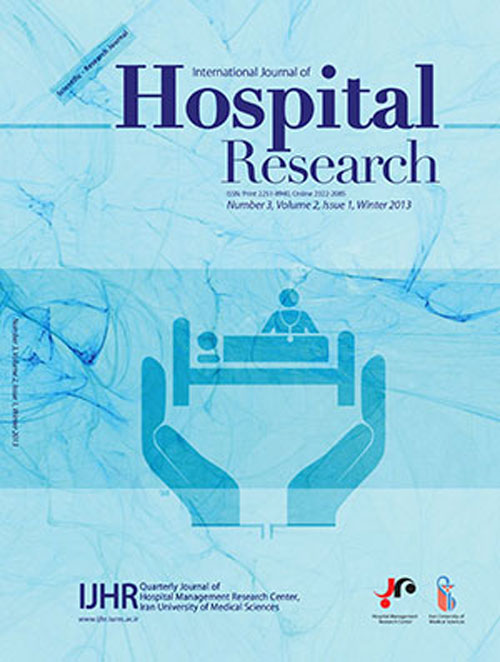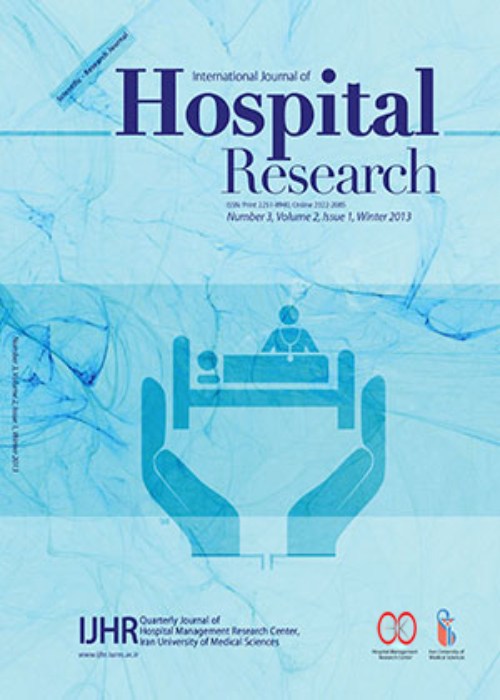فهرست مطالب

International Journal of Hospital Research
Volume:6 Issue: 2, Spring 2017
- تاریخ انتشار: 1396/06/20
- تعداد عناوین: 5
-
-
Page 1Background And ObjectivesRecently medical tourism as a new form of tourism has gained great popularity among the countries and a relatively large part of the world income is devoted to it. Since the high quality of service in the medical tourist's viewpoint has been a key factor in attracting and retaining them, the present study aimed to demonstrate which variables could affect the medical tourist's perspective about service quality.MethodsWe applied univariate analysis and multiple regression to explore the variables affecting medical tourists viewpoint about service quality they received. In order to measure thequality of service, we used SERVQUAL scale based on a gap model.
Findings: The findings showed nationality and type of therapy are the influential factors that affect patient's perspective.ConclusionsUnderstanding the demographic characteristics of medical tourists helps the authorities to make better decisions and change their strategies in offering services in order to raise medical tourist's attraction and trust and also develop this type of industry.Keywords: Medical Tourism, Servqual, Linear regression, Hospitals -
Page 2Background And ObjectivePseudomonas aeruginosa is an opportunistic bacterium and is one of the main causes of infection in burn patients. As this bacterium gets resistant to various types of antibiotics through different acquiring mechanisms, it can easily result in skin deformities and even patients death.MethodsThis descriptive study was carried out on 200 patients with burn injuries hospitalized in Specialized Burn Hospitals. Culture methods and diagnosis tests were used to separate and diagnose Pseudomonas aeruginosa, and disk diffusion Agar method with the Kirby-Bauer standard was applied to determine the pattern of drug-resistance. The antagonist effect of lactic bacteria isolated from 14 samples of milk and yogurt on the growth of Pseudomonas aeruginosa was also assessed using Agar well diffusion method.
Findings: In this study, 30 strains were diagnosed and isolated as Pseudomonas aeruginosa, out of which 45.2% were resistant to Gentamicin, 51.6% to cefotaxime, 48.8 to Imipenem and 45.2 to Ciprofloxacin. While studying probiotics, it was found out that most isolated strains belonged to lactobacilli, with Lactobacillus casei, with the average diameter of 20.3 mm, having the most inhibitory effect.ConclusionsThe results of this study showed that the spread of P.aeruginosa resistant to medicine is very high in hospitals and that the isolated Lactobacilli have a better inhibitory effect on drug resistant P.aeruginosastrains in comparison with other lactic bacteria. Therefore, using probiotic products would be more effective and could replace common antibiotics, and would help to treat patients with a great deal.Keywords: Pseudomonas aeruginosa, Drug resistance, probiotic, Burn, Antagonistic effect -
Page 3Background And ObjectivesNowadays health services affect a significant part of social, economic and political parts of each country. In this case, hospitals are considered as the important and final stage of health service supply chain. Consequently, quality of health services offered by hospitals has a straight impact on the safety of individuals.MethodsThe application of efficient operations research tools plays a key role according to the purpose of enhancing the performance of this vital section of health service supply chain. This paper aims at developing a design of experiments model (DOE) model based on computer simulation for the sake of optimizing important factors such as queue length, patient waiting time, departure rate and productivity. The DOE technique utilized in this paper is response surface methodology (RSM) and the proposed simulation model considers all wards and their relationships as well as their interactions together. This approach is designed and implemented in Shomal hospital located in North of Iran.
Findings: By taking advantage of the RSM technique by simultaneously considering optimum resource values, beneficial results have been obtained. For instance, risk mitigation of decision-making process by evaluating and analyzing different scenarios, reduction of queue length and patient waiting time could be mentioned as some satisfactory achievements.ConclusionsThis research is aiming at determining optimum levels of input factors in a real system, but some data related to some unpredictable events (such as human errors while gathering data) were eliminated. In conclusion, future works may encompass other industrial cases besides applying more precise and developed DOE techniques, to mitigate the risks and limitations encountered in this study.Keywords: Hospital Performance, Medical Processes, Simulation, Design of experiments, Response surface methodology -
Designing a model of Quality Management System (QMS) in the Hospital Incident Command System (HICS) in IranPage 4Background And ObjectivesHospital, as the organization providing healthcare services, should be systematically guided. Its success is the result of a successful healthcare management system. One of the management instruments having the effective role in services provided by healthcare systems is the Hospital Incident Command System (HICS). The present study is to generate this system.MethodsThe preset study is an applied one conducted in 2016. It uses an exploratory and consecutive mixed method research. At first, literature available in valid sites and databases was reviewed and then, Experts, selected via the Theoretical sampling technique, were interviewed. Finally, the data were extracted based on the previous stages and the Delphi Survey Technique was employed in three rounds. In the last round, the suggested model was presented. To validate the model, it was dephied again.
Findings: In the literature review section, ISO, accreditation, clinical governance and EFQM were identified as the mostly applied models in the healthcare organizations. According to qualitative interviews, five themes including achievements of the HICS and influenced dimensions, strategies and priorities, the models for improving quality in healthcare centers, and suitable model of the HICS were obtained. Moreover, the final model was complemented based the conducted rounds in the Delphi technique by merging similar standards and developing necessary components.ConclusionGiven the challenges, the use of quality instruments for filling gaps in the HICS seems necessary for its implementation. According to the findings, the final model was generated by focusing on standards of structure, process, and outcomes. At last, the main and secondary components of the model were designed by improving the performances of services presented in healthcare centers, and the outcomes and results of those performances for patients, the staff, organizations, and the society.Keywords: Quality Management System (QMS), Hospital Incident Command System, Hospital, Evaluation, Delphi Technique -
Obstetrician's Review on the Health Section Evolution Plan in Iran: A Quality-Case StudyPage 5Background And ObjectivesThe Increase of unnecessary cesarean sections has become one of the serious concerns in some health systems. The present study aimed to assess the challenges and strategies of promotion of vaginal delivery instruction from the perspective of Obstetricians and Gynecologists in Isfahan in 2015.MethodsIn this qualitative study, semi-structured interview was used from the perspective of obstetricians. Sampling was targeted and saturated by 15 interviews. The interviewees were assured that their information will remain confidential. Thematic analysis was used to analyze the data.
Findings: Finding demonstrated that instruction of promotion of natural childbirth has achieved the first 2 aims including "making the natural childbirth franchise free" and "reducing C-section rate", however, it has almost not realized other aim containing " Motivating service providers(experts)", and " Improving natural childbirth facilities standards". Thematic analysis proved that participants consider the factors containing culture ignorance, Obligatory Increase for natural delivery rate , Not giving attention to Law reform at the natural childbirth, An unacceptable Tariff Payment System, and Payment delays on new tariffs as the most significant challenges and shortages of above-mentioned instruction.ConclusionsPromotion of natural childbirth instruction has somewhat realized its aims in Isfahan; however it has significant shortages and limitations. Obligatory Increase for natural delivery rate and medical ethics are the most prominent ones which need to be studied.Keywords: Obstetricians, Gynecologists, Promotion of Vaginal Delivery Instruction, Iran


